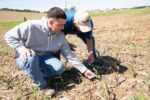Soil Health
Hedging Your Long-Term Weed Control Bets to Reduce Herbicide Reliance
No-tiller and crop consultant Jon Spreng, Perrysville, Ohio, says the biggest challenge to combining no-till and cover crops is finding a permanent weed control solution.
Read More




